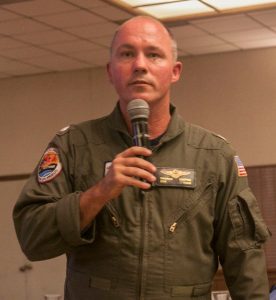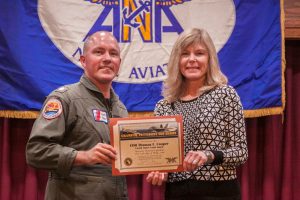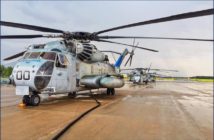Gramps was honored to have CDR Thomas F. Cooper present to help celebrate the one hundredth year of Coast Guard Aviation. He was introduced by our OPS officer Cynthia Macha who immediately pointed out the common feature in each of their lives: They both were twins! Tom’s twin was a classmate at the Coast Guard Academy with him and both went into aviation. His twin, David, is currently C.O. of the USCG Air Station in New Orleans, the same duty our speaker, Tom, has at LAX. There are plans, however to transfer the LAX air station to the Navy base at Point Mugu. This will only change their base of operations but not change the coverage of the group.
The first CG Aviator was Elmer “Archie” Stone, a name immediately recognized by a member of our audience when asked by our speaker! Stone and another officer, Norman B. Hall, suggested that the Coast Guard utilize aircraft in their work. They became the first pilots to train and become aviators in the Coast Guard one hundred years ago leading to the Coast Guard Aviation branch.
One of the aircraft used was the Sikorsky HH-52 helicopter that first flew in 1959. A retired HH-52 was at Van Nuys as part of a school there and was once restored to flight status. It is currently on display at the National Museum of Naval Aviation in Pensacola FL. The Coast Guard keeps their aircraft in service for longer than usual lifespans due to careful maintenance and upgrades.
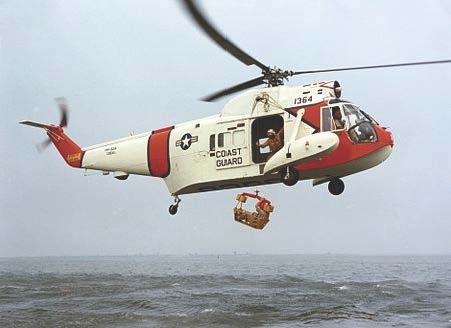
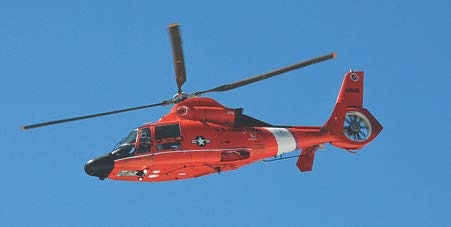 The LAX station currently has three MH-65 Dolphin Eurocopter helicopters in service. They carry a crew of four including a rescue swimmer and a medic along with two pilots who are especially useful in marginal weather conditions. The area they cover extends from Dana Point to Morro Bay. They serve many functions and perform unusual rescues such as a rescue of a person on a golf course on Catalina Island. He was picked up and transported back to the mainland due to the lack of advanced medical facilities on Catalina in addition to the difficulty and time for transportation. They rescued a diver at night who was trapped in kelp and had been there for some time. He was found by the observation of an unusual light where there was none expected. It turned out to be a diver with a flashlight and the crew investigated and found a trapped diver. They lowered a basket but did not have a rescue swimmer aboard so they had to maneuver the basket to tear him out of the kelp that had him trapped. The diver managed to get a hold of the basket, partially climb on board and the team was able to tear away the kelp and rescue the diver with the lift from the helicopter. He was taken to the Catalina Dive Chamber for resuscitation and survived. They are on alert twenty four hours a day for search and rescue missions and their unit has been in service since 1962.
The LAX station currently has three MH-65 Dolphin Eurocopter helicopters in service. They carry a crew of four including a rescue swimmer and a medic along with two pilots who are especially useful in marginal weather conditions. The area they cover extends from Dana Point to Morro Bay. They serve many functions and perform unusual rescues such as a rescue of a person on a golf course on Catalina Island. He was picked up and transported back to the mainland due to the lack of advanced medical facilities on Catalina in addition to the difficulty and time for transportation. They rescued a diver at night who was trapped in kelp and had been there for some time. He was found by the observation of an unusual light where there was none expected. It turned out to be a diver with a flashlight and the crew investigated and found a trapped diver. They lowered a basket but did not have a rescue swimmer aboard so they had to maneuver the basket to tear him out of the kelp that had him trapped. The diver managed to get a hold of the basket, partially climb on board and the team was able to tear away the kelp and rescue the diver with the lift from the helicopter. He was taken to the Catalina Dive Chamber for resuscitation and survived. They are on alert twenty four hours a day for search and rescue missions and their unit has been in service since 1962.
Their priorities are airspace where drones are a significant hazard. The age of their aircraft is an issue as they grow older requiring especially careful care, inspections and maintenance. Standardization is another priority. Some of this involves standards for cliff rescues as well as landing aboard ships, oil rigs and mountain landings, all very critical operations. They are also now using HUDs (heads-up-displays) for work at night to detect smugglers at sea. They are aided by some volunteer pilots and their private aircraft. We are very grateful to CDR Cooper for his service (as well as that of his twin) and to the Coast Guard for all the lives it has saved in the past 100 years.


